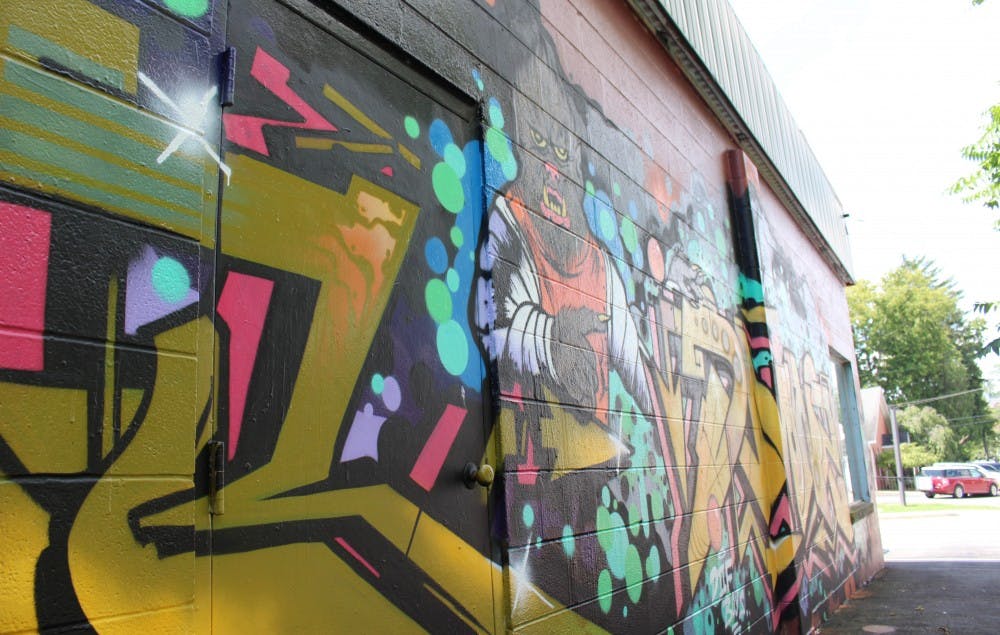A mural on the side of a building on Kirkwood Avenue, spray-painted vandalism on a campus landmark and the tag of a well-known artist are often placed in the same category.
Graffiti, defined by associate professor Malcolm Smith historically as markings on public walls or spaces, is used contemporarily to describe all of the above types of expression.
Early this week, the phrase “college is capitalism” was painted on Collins Living Learning Center and quickly power washed away. Smith said there is a difference between overt political statements, such as the one at Collins, larger murals and the craft of graffiti.
Smith said that sort of art does not exist in the realm of graffiti as he and other graffiti artists view the term.
“It’s not to be confused with street art and general vandalism,” Smith said. “There’s a sort of ethical culture in the true graffiti subculture that avoids calling attention to or defacing buildings that have intrinsic value.”
The Bloomington city government has the Graffiti Eradication Program in place, and the definition of graffiti they use is vandalism typically done with aerosol spray paint but also with paint markers, grease crayons and window etching fluid.
According to the program’s web page, the city divides graffiti into four categories: hip-hop, which includes many types of expression linked to hip-hop culture; ideological or hate graffiti; gang tags; and generic graffiti, a category that includes simple statements with no apparent artistic intent.
Dave Williams, operations and development director for Bloomington,said his part of this program deals specifically with parks and public spaces.
“We do have a lot of graffiti on our parks’ facilities and trails, pavements, statuary and park benches. We have a big problem with that,” Williams said. “Our management priority is to remove it upon discovery within 24 hours.”
Some of the other departments involved in the Graffiti Eradication Project include public works and housing and neighborhood devel opment.
To combat what the city defines as graffiti, Williams said they try to remove the message or image immediately, regardless of whether the message is positive or negative.
“A park facility, any public facility that is allowed to be tagged and does not have the graffiti removed sends a really inappropriate sign to the public that this building is not being protected,” Williams said.
According to Smith, graffiti as it has evolved in the last 40 or 50 years, is an artistic subculture and tends to take the form of a person’s tag name covering a specific area to take aesthetic ownership and making a statement to other artists that the space has been claimed.
“They’re not looking for buildings that have architectural value — they look for blank spaces, cinder block walls, things that look like they need improvement via color, via some design in some way,” Smith said.
[Local photography studio welcomes street art]
Williams said the city has placed mural boards along trails and has collaborated with certain artists to create murals and possibly lessen instances of vandalism on public property.
Smith said he views artists working in broad daylight and creating symbols of community as distinct from the graffiti subculture.
Within Bloomington are a number of active graffiti artists, whose work goes up in both sanctioned and unsanctioned areas of town, Smith said. These are people whose work follows the graffiti artist’s ethical code of warding off vandalism and competing actively with one another, the larger graffiti artist network in the country and the open space online.
A good example of an area in which the three categories of expression — graffiti, mural and spray-painted vandalism — coexist is the B-line trail leading up to the Farmers’ Market, Smith said. This area includes one section of wall deemed sanctioned space for graffiti but also includes tag and outright vandalism not to be confused with graffiti.
“Graffiti as a form of expression or subculture activity will persist and its mechanisms will continue no matter what,” Smith said. “That’s the defining aspect, it doesn’t need sanctioning or not sanctioning for that to happen.”






